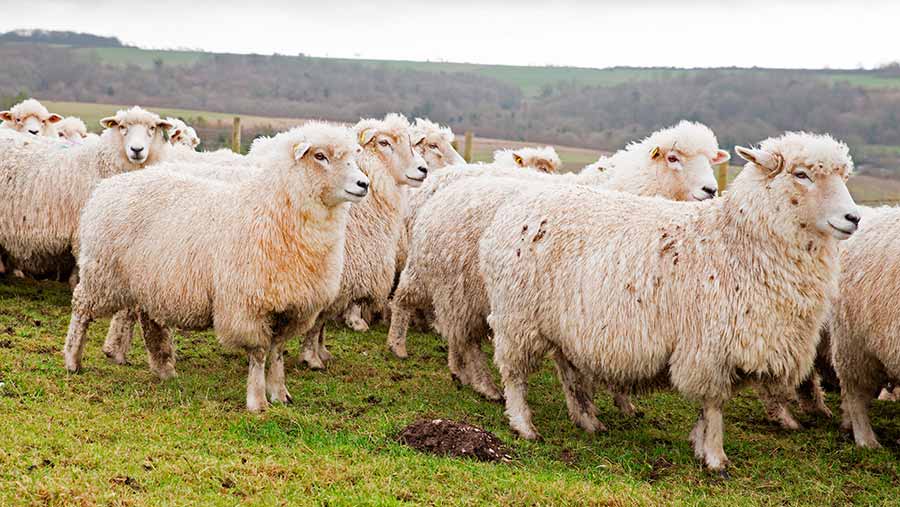Guide to breeding from ewe lambs
 New Zealand Romney sheep. © Alexandra Joseph
New Zealand Romney sheep. © Alexandra Joseph Most UK sheep producers hold ewe lambs for a year to breed as yearlings, but this means losing 12 months of income.
Economics are now persuading some to rethink their breeding policy.
With good management and nutrition, ewe lambs can successfully produce offspring at 12 months old, says independent sheep specialist Kate Phillips.
See also: Pay attention to ewe lamb feeding to ensure results
Mrs Phillips and Katie Brian, senior knowledge transfer manager at AHDB Beef and Sheep, outline 16 key considerations for lambing young ewes:
- Ewe lambs need to be well grown to achieve puberty and must reach 60-70% of their mature bodyweight prior to tupping, so ensure you select stronger lambs, possibly from well-grown twins, for mating.
- Lambs must grow by 200-250g a day until six weeks post-tupping.
- Breed ewe lambs away from the main flock because they are less competitive for the ram’s service.
- Use experienced rams rather than ram lambs. Use teaser rams – one ram to a group of 100-150 ewe lambs – allowing 14 days with the teaser before introducing fertile rams, although some farmers give two cycles with teasers.
- Leave the fertile rams in for just one cycle so that lambing is not too strung, but this depends on the farmer and what he is prepared to accept. One mature ram would manage 50 ewe lambs, but a greater ratio may be needed as ewe lambs are not as obliging as mature ewes.
- Ewe lambs also have a shorter breeding season than older ewes because they begin cycling later. Lambs born relatively early in the season will generally cycle earlier in the year than lambs born later, partly due to their heavier bodyweight and partly due to their age.
- Select an easy-lambing breed of tup. You don’t want anything with too big a head or shoulders.
- Avoid multiple births. To achieve this don’t overfeed ewe lambs in the run up to, and during, mating. Six weeks after tupping, growth should slow down to around 130g a day, up until six weeks before lambing.
- Get feeding right. Pregnant ewe lambs are still growing and therefore have higher nutritional requirements than ewes; during early and mid-pregnancy, ewe lambs need around 20% more feed than mature ewes to sustain their growth.
- It is vital to scan at eight weeks post-tupping to identify animals carrying more than one lamb, but also expect a higher percentage of empties within a group of ewe lambs (realistically you wouldn’t expect more than 80% to be in lamb). By identifying non-pregnant animals at scanning, a decision can be made on whether to sell for slaughter or to keep for breeding in the following season.
- Ensure lambs are at optimum body condition score three six weeks before lambing starts.
- Do not overfeed in the last few weeks before lambing. Ewe lambs should be fed only for maintenance and pregnancy, not growth, so feed as you would for a mature ewe of the same weight, or you will create problems at lambing. Otherwise you will create large single lambs and lambing difficulties.
- Ewe lambs are also less aggressive at the feed trough and should be fed and managed separately from mature females.
- Any ewe lambs carrying twins should be managed separately in the last six weeks of pregnancy.
- If a ewe lamb is carrying twins, it should rear only one otherwise it will put too much pressure on the ewe lamb – affecting her body condition and future performance and lamb growth rates. It will also make her more prone to mastitis and udder damage as milk production is lower in ewe lambs.
- Wean lambs earlier at 10-12 weeks of age to prevent body condition falling. A ewe lamb has a high nutrient demand for growth – 6-7 MJ for a daily gain of 200g in lactating ewe lambs.
Scanning percentages
- Empty rate: 19.5%
- Singles: 68%
- Twins: 12%
- Triplets: 0.5%

Robert Hodgkins. © Tim Scrivener
Case study
Ewe lambs producing a lamb in their first year can be the most profitable animals in Robert Hodgkins’ performance-recorded flock of 1,200 New Zealand Romneys.
Lambing the ewe lambs from 1 May, a month after the main flock, means their offspring are sold into the more lucrative January and February market.
“Even if they only yield 16kg carcasses, the higher price means they compare well to a 19 or 20kg carcass sold earlier in the year,’’ says Mr Hodgkins, who farms with fiancée Jo Franklin.
They farm rented land in Stevenage, Hertfordshire, and receive no subsidy so every animal must generate an income. “Every mouth has got to pay,’’ says Mr Hodgkins.
Ewe lambs for breeding – 204 this year – are selected using the New Zealand performance recording system – SIL.
Mr Hodgkins selects for the best overall EBV.
“We don’t select on individual traits because by doing so we could sacrifice other traits,’’ he explains.
The ewe lambs are run separately from the main flock and Mr Hodgkins tups these with the top 2% New Zealand Romney rams from his parents’ flock.
Teaser rams are turned in with the ewe lambs for 30 days, from 1 November, to give them two full breeding cycles.
On 1 December the fertile rams are turned in for a month.
Ewe lambs are out-wintered on stubble turnips and get the best grazing. “We didn’t feed any concentrates last year but I wouldn’t be averse to top-up feeding if they needed it,’’ says Mr Hodgkins.
This year 138 of the 204 ewe lambs scanned as carrying singles, 25 twins and one with triplets. Forty were empty but Mr Hodgkins says many were animals he should probably not have included in the breeding programme.
“We are in the process of building numbers so kept back 30 that should possibly have gone for meat.’’
Unless the ewe lamb is very fit, she will have only one lamb to rear. Based on this year’s scanning results there will be 27 orphan lambs to rear – a disadvantage of lambing them later than the ewes.
But they are reared on milk for five weeks then weaned.
Mr Hodgkins says ewe lambs often make the best mothers. “They get straight back into it second time around but the challenge is maintaining body condition.’’
To achieve this they are weaned at 80 days compared with 100 days for ewes. Ewe lambs are also kept on stubble turnips from the beginning of September right through to February. They also get an iodine drench or bolus during this period.
